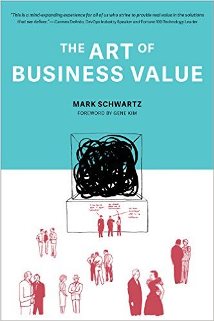Business value is often a misunderstood concept in the IT world, yet as technology leaders, we all agree that delivering it is our goal. Agile and Lean approaches take an especially strong stance, declaring that only value delivery really matters, not necessarily adherence to cost and schedule milestones.
But what is this business value thing, exactly? And what is the CIO’s role in delivering it?
We sometimes confuse business value with customer value or user value. But business may not always value what its customers or users value. Imagine a business that wants to lose the least profitable 10% of its customers - adding business value might mean destroying some customer value. Or, imagine a transformational initiative at a business where management’s vision of the future is uncomfortable for many of its employees. Business value perhaps is not what these users value.
Flaws with common IT value measures
Some try to use concepts such as return on investment (ROI), net present value (NPV), or shareholder value added (SVA) as a definition of, or proxy for business value. But each of these concepts poses difficulties when used to govern IT projects.
ROI ignores the time value of money and the real option value (possibility of deferring decisions about incremental work until more information is known) latent in features; NPV projections are highly sensitive to assumptions about revenues, competitor reactions, and the company’s ability to capture cost savings; and shareholder value is difficult to project, and hard to define in private companies, nonprofits, and government agencies - that is, in almost every business organization.
Even more dangerous is the idea that “the business” is responsible for knowing or deciding what business value is. The very idea leads to a mindset of “toss requirements over the wall and have IT provide customer-service," a model which deprives the CIO of influence over value decisions.
Agile approaches promise better collaboration between IT and the business: with autonomous teams of software developers working directly with business people. But this does not solve the problem entirely.
Outdated customer service IT
In the classic Waterfall approach, IT is like the person behind the counter in a fast food restaurant, taking orders and then serving them up. With the shift to an Agile culture, IT has become more like the salesman in a fashionable clothing store. Now IT helps the customer decide what he or she really wants by making suggestions and giving the customer outfits to try on in order to elicit information about what the customer is really looking for.
I’ve never worked in a fashionable clothing store, but as a customer I have observed that a good salesperson first gets agreement from the customers on the basic outfit and then procceds to get customer agreement on a shirt, accessories, and shoes. It is an incremental, iterative, and joint process.
But the salesman is still an order taker. It is the customer who makes value decisions.
This customer service view of IT is no longer appropriate, nor is the very distinction between IT and the business, since the two together form a single enterprise trying to realize business outcomes.
In his comprehensive study, Lean Enterprise, Jez Humble points out that the distinction between IT and the business is an outdated one. “In high-performance organizations today,” he says, “people who design, build, and run software-based products are an integral part of the business. They are given—and accept—responsibility for customer outcomes.” Of course I have to quibble with Jez on his reference to customer outcomes; I’d prefer to generalize it to business outcomes. But the sense of the IT function as a full participant in business value definition and creation is there. It is hard not to notice that the role that is attributed to the Agile teams is also attributed to the IT organization as a whole.
What is the CIO's role in business value?
The IT organization—and by extension the CIO—is in a unique position when it comes to interpreting the business value of IT investments. As a team of professionals, it understands the state of the art, the emerging ideas and technologies, the best practices for execution.
 The IT organization can see across the enterprise to find synergies across the technology portfolio and align the portfolio with the business’s strategy. It has the accumulated knowledge and wisdom on what will create enterprise IT value. It understands the possibilities and benefits of technology and what benchmarks to use in assessing performance. It formulates strategies for security and compliance, for use of budgeted funds, and for hiring appropriate technical skill sets. It manages costs and negotiates contracts.
The IT organization can see across the enterprise to find synergies across the technology portfolio and align the portfolio with the business’s strategy. It has the accumulated knowledge and wisdom on what will create enterprise IT value. It understands the possibilities and benefits of technology and what benchmarks to use in assessing performance. It formulates strategies for security and compliance, for use of budgeted funds, and for hiring appropriate technical skill sets. It manages costs and negotiates contracts.
But Agile approaches leave the CIO in a strange position: autonomous IT teams are working directly with the business to deliver value. The product owner—in a Scrum process—or other business representatives define and prioritize features; the autonomous team then self-organizes to turn them into IT capabilities.
Well, then, what need have we for a CIO? How can the CIO participate in value delivery, much less oversee it?
Value in the IT asset
The answer to this question, I believe, lies in the business value of the organization’s IT asset: the total of the organization’s IT capabilities with all of its latent possibilities, its ability to support the business’s needs today and in the future in an agile, responsive manner. The CIO’s role in the Agile environment is to oversee the development and fine-tuning of this asset.
It is common in Agile circles to think of a business as an evolving, Complex Adaptive System, with feedback loops, complex interactions, and unpredictability. In such a context, leaders lead through influence, through setting visions and incentives to guide the evolution of the business enterprise. Therefore, the CIO can lead (but not “control”) the delivery of value by autonomous teams, setting the vision and influencing direction to mold the business’s IT asset.
Excerpted and adapted from Mark Schwartz's new book, The Art of Business Value.


Written by Mark Schwartz
Mark Schwartz is an Enterprise Strategist at Amazon Web Services. Prior to AWS he served as CIO of the United States Citizenship and Immigration Services (USCIS) for 7 years. He is the author of A Seat at the Table: IT Leadership in the Age of Agility and The Art of Business Value.



